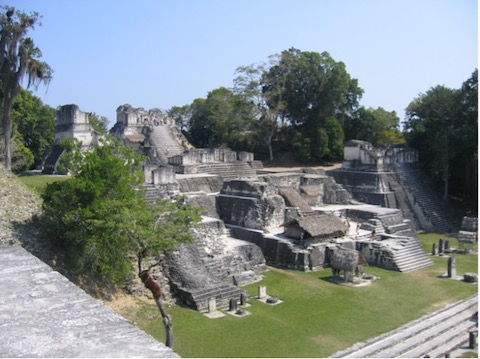
The Maya ruled central America for 1200 years, creating written language, mathematics, and spectacular architecture.
Then, in AD 900, they mysteriously abandoned their cities, and their empire crumbled. Contaminated water may have played a role.
At their ancient capital of Tikal, 60,000 citizens relied completely on rainwater trapped in reservoirs.
But the rain also washed red mercury paint, which the Maya used to decorate the city, into the reservoirs.
They recognized the problem and devised a way to purify the water—the first people to do so.
They discovered that zeolite—a mineral derived from volcanic ash—could trap heavy metals like mercury in water, and that quartz sand could clarify it.
So, where the rainwater entered one of their largest reservoirs, they built a permeable limestone dam filled with zeolite gravel imported from a nearby deposit and backed by quartz sand held in reed mats.
This system worked so well that, to this day, no traces of mercury have been found in the reservoir.
However, severe droughts in the late 800s may have reduced or evaporated this potable water supply, forcing Tikal’s residents to rely on other reservoirs without the filter system, which are still highly contaminated.
Meanwhile, the Maya people live on: 40% of today’s Guatemalans descend from them. Their zeolite water purification system lives on too, in today’s wastewater treatment plants.
Background
Synopsis: Archaeologists recently discovered the world’s most ancient water purification system. Centuries before Asian and European cities developed methods to clean water, the Maya city of Tikal in modern Guatemala used natural zeolite minerals for water purification and quartz sand for water clarification. For nearly 1000 years, these systems provided Tikal’s population with safe drinking water, until the city’s decline around AD 900. Today, the same concepts and minerals are used in swimming pool filtration.
- Zeolites are a group of microporous hydrated aluminosilicate minerals often described as “molecular sieves” because their molecular structure is like a honeycomb of interlocking SiO4 and AlO4 tetrahedra.
- They have strong adsorption and ion-exchange properties and are capable of capturing impurities such as microbes, heavy metals, and nitrogen compounds from fluids.
- Zeolites give up their contents and water (in the form of steam) when heated, explaining their name, which is derived from the Greek words “zeo” (to boil) and “lithos” (rock).

- Natural zeolites form when volcanic ash and tuff interact with alkaline groundwater, sometimes creating rare, spectacular crystals in the vesicles of volcanic rocks.
- There are about 50 natural zeolite minerals. Today, they are used in pet litter, animal feed, soil conditioners, wastewater treatment, and swimming pool filters.
- More than 150 synthetic forms of zeolite are used as catalysts, detergents, and filters. The extraction of gasoline from petroleum depends on zeolites.
- Today, the top global producers of zeolites are China, South Korea, Japan, Jordan, Turkey, Slovakia, and the United States.
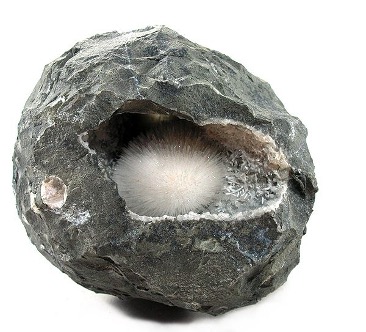
- As long as 2700 years ago, Greek and Roman engineers used zeolites in the construction of water-bearing structures like aqueducts, bridges, dams, and harbors, but it was thought that zeolites were first used for water purification in the early 1900s.
- However, a recent study of three reservoirs in the Maya city of Tikal found that one of them contained crushed zeolite that was transported from miles away some 2,185 years ago.
- The Maya appear to have discovered that zeolites purify water more than 2000 years before their first use in modern city sanitation.
- Maya civilization thrived in the tropical lowlands of Mesoamerica, starting with a collection of agricultural communities around AD 250 and reaching its peak ca. AD 600.
- The Maya empire was centered on present day Guatemala, stretching across Belize and the Yucatan peninsula westward into the Mexican states of Tabasco and Chiapas.
- During its heyday, the Maya civilization included about 40 city-states with populations ranging from 5,000 to 50,000.
- Known for their agricultural practices, hieroglyphic writing, mathematics, and calendar development, the Maya also left behind impressive architecture.
- Their distinctive artwork features red cinnabar (mercuric sulfide) decorations.
- A few hundred years later, the Maya civilization declined suddenly, leaving its cities mysteriously abandoned by AD 900.
- Theories for their demise include overpopulation and environmental degradation, intra-city warfare, and catastrophic droughts evidenced from AD 820 to 870.
- The cities may have disappeared, but the people didn’t—about 40% of modern Guatemalans are descended from the Maya. Today, ~5 million people in the region speak some 70 Mayan languages, as well as Spanish.
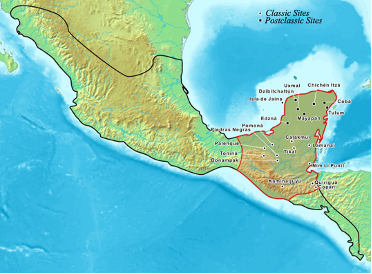
- Given their engineering capabilities and highly populated city centers, it should be no surprise that the Maya were forced to address water quality issues.
- Tikal—known as Yax Mutal to the Maya people—was one of the first and largest Maya population centers, and an important post in the Mesoamerican trading network. The ruins of the city became a UNESCO World Heritage Site in 1979.
- Around AD 700, about 10,000 people are believed to have lived in the 1-mi2 (2.5 km2) city center, with about 50,000 more residing in the outlying areas.
- Along with stepped pyramidal temples, palaces, and complexes, the ancient city of more than 3000 structures features 10 large reservoirs.
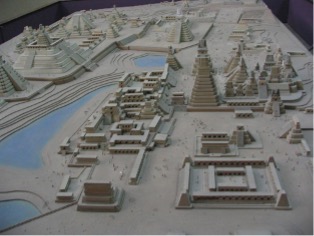
- At 600 ft (200 m) below the karst limestone surface, the groundwater table was unreachable for the Maya. Tikal’s setting in the tropical rainforest away from lakes and rivers made the city totally dependent on rainwater recharge for both irrigation and drinking reservoirs.
- The water in these reservoirs was essential to the survival of the city during dry seasons… if it was potable. But recent assays of four of Tikal’s largest reservoirs indicate that two of them were severely contaminated.
- High levels of mercury, phosphate, and cyanobacteria in the palace and temple reservoirs suggest toxic pollution could have threatened the city as the reservoirs eutrophied and receded during drought, poisoning residents and possibly leading to Tikal’s abandonment.
- Mercury could have come from the abundant red cinnabar (HgS) pigment used in Maya artwork or from nearby active volcanic fallout.
- The Perdido reservoir, believed to be a source for irrigation water, was farther from sources of mercury and was less contaminated.
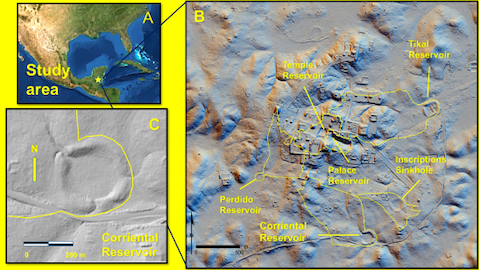
- The fourth pool, the Corriental reservoir to the south of the city, did not contain these toxins, but a separate study showed it was the only reservoir that contained both zeolite and quartz sand!
- Quartz and zeolite are not found near Tikal, so these materials would have been imported.
- Quartz sand would have provided clarification, but it would not have removed harmful heavy metals or toxic microbes from the water.
- The closest outcrop of zeolite is 18 mi (30 km) to the northeast, at Bajo de Azúcar, where an aquifer flows exceptionally clean, sweet water from a weathered volcanic tuff. The outcrop zeolite is a geological match for the Corriental reservoir zeolite.
- Radiocarbon dating of the sediment containing the zeolite shows the reservoir was in use for over 1000 years, between 2185 and 965 years ago.
- The researchers developed a picture of how the filtration system must have worked: Storm water entered the upstream end of the reservoir through channels dammed by permeable stone barriers that included layers of zeolite for purification and quartz sand for clarification encased in woven matting material.
- Over the centuries, the plant-based matting would have deteriorated, resulting in zeolite and sand spilling into the main part of the Corriental reservoir.
- These reservoir sediments did not show the same toxic contaminants as the other reservoirs, and there was absolutely no trace of mercury or cyanobacteria.
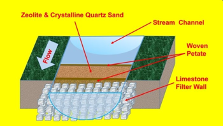
- This Maya engineering innovation of what the researchers called “the oldest known use of zeolite for decontaminating water in the world” preceded any other zeolite water quality application by about two millennia. Researchers plan to look for similar systems in other Maya cities.

